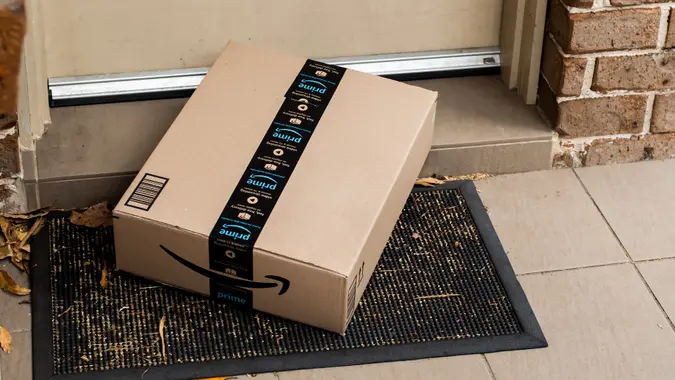This Is How Much I Spend Each Week on ‘Healthy’ Groceries

Commitment to Our Readers
GOBankingRates' editorial team is committed to bringing you unbiased reviews and information. We use data-driven methodologies to evaluate financial products and services - our reviews and ratings are not influenced by advertisers. You can read more about our editorial guidelines and our products and services review methodology.

20 Years
Helping You Live Richer

Reviewed
by Experts

Trusted by
Millions of Readers
You don’t have to overspend to eat healthy. According to the USDA, the average U.S. household spent between $5,278 and $16,996 on food in 2023, depending on income. This breaks down to $440 to $1,416 a month.
If you wish you could eat healthy while still keeping to a budget, you’re in the right place. GOBankingRates spoke with Nahyeli Perpina, RDN, CNSC at Culina Health, to find out how much she spends on groceries and what healthy foods she buys.
Here’s what she shared.
Weekly Grocery Budget: $200
“We typically spend $200 per week (give or take),” said Perpina. “That includes fresh produce, quality proteins, and snacks for all four of us, with bulk buys from Costco helping stretch things further.”
Perpina shared that her family mainly shops at Aldi, Costco and Publix — stores commonly known for being budget-friendly. Her family also does one big grocery haul a week.
To keep costs low, she also uses smart shopping strategies like:
- Store apps for BOGO deals
- Digital coupons
- Members-only savings at select stores (e.g. Costco)
Plus, she scans her receipts through Fetch to get free gift cards. If you’re not familiar, Fetch lets you earn rewards on every purchase. Some of the gift cards include Amazon, Google Play, Ulta Beauty, Starbucks and CVS Pharmacy.
Weekly Staples and Meal Planning
Meal planning and shopping with a list are key to keeping costs low and avoiding impulse buys. These are some of the top weekly staples Perpina’s family always buys:
- Produce: bananas, grapes, avocados, apples, cucumbers, spinach, rainbow baby carrots, cherry tomatoes, strawberries, potatoes, onions, blueberries and clementines
- Proteins: chicken breasts/thighs, eggs, ground beef, canned tuna and Greek yogurt
- Grains and pantry staples: oats, jasmine rice, pasta, canned beans, tomato sauce, corn tortillas, cereal and peanut butter
- Dairy and dairy alternatives: milk, butter, shredded cheese and plant-based milk
- Frozen items: waffles, chicken nuggets, salmon filets, fruits for smoothies and mixed veggies
- Condiments and salsa
- Snacks: whole grain crackers, hummus, popcorn, cheese sticks and dark chocolate
Perpina added that many of these ingredients are “nothing fancy, just flexible and budget-friendly.”
As for weekly meals, while that can vary, here are a few common options in her household:
- Oatmeal with cinnamon and berries
- Eggs, avocado and toast
- Smoothies
- Greek yogurt, fruit and granola
- Sandwiches
- Leftovers from dinner
- Easy rice bowls (using existing ingredients in the kitchen or pantry)
- Sheet-pan chicken and veggies
- Tacos
- Baked salmon with rice and salad
- Stir-fry
- Pasta with veggies
As for snacks, she said, “Fruit, hard-boiled eggs, trail mix, and way too much popcorn. It’s our favorite ‘something crunchy.'”
Smart Swaps for Nutritious Eating Without Overspending
There’s no limit to the different ways you can save money while still eating healthy. Don’t worry if you’re not sure where to start.
“Here’s the good news: you don’t need fancy powders or a $15 smoothie to eat well,” said Perpina. “As a dietitian and a full-time mom, I’ve cracked the code on eating healthy without draining your bank account and I’m sharing my favorite tips with you.”
Here are the big ones:
- Plan what you’re going to buy in advance.
- Use in-store apps to get those digital coupons, BOGO deals and weekly specials.
- Plan your meals around the weekly specials.
- Scan your receipts with Fetch for extra rewards/gift cards.
- Stock up on things like proteins, grains and snacks, but only get the things you’re going to use.
- Only get what you’re going to use; buy everything else frozen.
- Shop in season to get better deals.
- Make your own healthy snacks — like trail mix or popcorn.
- Double up dinner recipes to have leftovers the next day.
- Cut down on how much meat you use, and swap out the meat for something like black beans or lentils.
- Check the entire shelf, not just what’s eye level, the ingredients you can easily see usually cost more.
Don’t be afraid to experiment with the different ingredients you use. And remember, every person — and family — is different, so you’ll want to make sure everyone’s getting the nutrition they need.
More From GOBankingRates
Sources:
- USDA, Food Prices and Spending
- Nahyeli Perpina, Culina Health
 Written by
Written by  Edited by
Edited by 

























